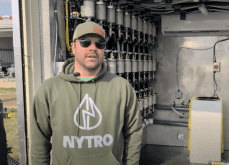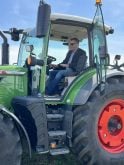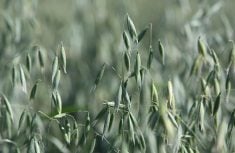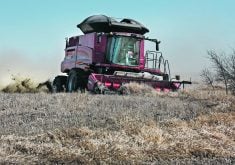ST. CLEMENTS, Man. – Pete and Irene de Graaf planted their entire century farm to poplar and willow trees in June 2005. Some are already 15 feet tall.
“My dad spent his youth, 20 years, clearing this land by hand and horse,” says Irene.
“If he saw me putting it all back into trees, I’m sure he’d have a below-the-grass tantrum.”
She says for most of the past century the farm has grown mainly vegetables. In recent years, they’ve leased it to local grain farmers.
The farm is an original Red River lot, dating back to the Selkirk settlers in the early 1800s, so it’s a long narrow piece of property.
Read Also

VIDEO: Ag in Motion documentary launches second season
The second season of the the Western Producer’s documentary series about Ag in Motion launched Oct. 8.
That makes it difficult for the de Graafs to find renters because today’s implements are hard to manoeuvre on long, narrow fields.
Pete says by 2005, he and Irene were trying to figure out a viable future for their 100 acre field. It’s situated a few hundred feet from the Red River and is productive. Permanent forage presented one option.
The de Graafs also could have developed the land for housing, given its convenient location about 30 kilometres north of Winnipeg.
That likely would have earned them enough to make their retirement financially worry free, but both Pete and Irene gave the option the thumbs down.
Despite new houses popping up all around them, the de Graafs were firm that the farm would not be turned into a subdivision.
“Expanding suburbia is the wrong thing to do, from a practical point of view and a philosophical point of view. The footprint of our cities are expanding at a time when we should be contracting that footprint,” says Pete.
“Good agricultural land is disappearing at an astounding rate. Once the concrete goes in, the farmland is gone forever. You cannot retrieve it.
“But with this land in trees now, who knows? Maybe someday in the next century it’ll be a vegetable farm again.”
Irene says she just happened to catch a radio interview about planting poplar and willow for biomass, bioenergy, bioproducts, lumber and carbon credits. That gave her the first inkling that the Forest 2020 program might fit their retirement plans.
Forest 2020 focuses on expanding fibre supply by establishing fast growing plantations and enhancing forest management in existing forests as part of the federal government plan to address climate change.
Pete works as an agricultural engineer with the National Research Council. Irene is a mediator with the provincial government.
They both grew up on vegetable farms so knew from experience that the vegetable farm option would require more work than they were willing to tackle in their retirement years.
However, they thought a commercial poplar and willow farm would require less time, energy and money. After all, these trees grow like weeds wherever they’re not wanted.
“Boy, were we wrong about that,” Irene says.
“We’ve both pushed back our retirement to support this new farm venture. But I guess that’s not unusual for farmers nowadays.”
The day Irene heard about the Forest 2020 initiative, she contacted project co-ordinator Derek Sidders at the Canadian Forest Service.
Sidders thought the location was ideal for demonstration purposes. It was close to Winnipeg, only 40 minutes from the airport and situated on an all-weather road, which has since been paved.
However, the forest service had already selected the eight prairie sites for the first round of Forest 2020 experimental plantings, so the de Graaf farm went to the bottom of the waiting list.
Five days later, Sidders called Irene back to say he had rounded up enough poplar and willow to cover their entire 100 acres and he was in his truck driving out to inspect the idle field as they spoke.
Sidders reminded her that the Forest 2020 project was in the experimental stage, and she should not expect immediate success.
“Pete and I were all in favour of the experiment, that’s for certain. But it all happened too suddenly,” recalls Irene.
“We had no time to prepare the land. There were cereal volunteers, canola, weeds, everything. Knowing what we know now about weeds and young trees, it should have been in summerfallow two or even three years.
“Plus it was such a wet spring that we couldn’t get out there to cultivate or spray. Our planting deadline was June 28. Because of the mud, we couldn’t start planting until June 25. We hired as many people as we could find and planted trees as fast as possible.”
The plots designated for biofibre, bioproducts, lumber and future carbon credit trade are called afforestation plots.
On the de Graaf farm, these plots add up to 80 acres of different species and techniques.
These trees are primarily poplar, planted at a rate of 650 stems per acre.
The trees are planted on a 2.5 metre square grid, which allows Pete to cultivate north and south, east and west, and diagonally.
The trees are expected to be ready for commercial sale in 17 years. While the de Graafs wait, there may be a potential for income through carbon credits.
The remaining 20 acres of willow make up the concentrated bioenergy plots, intended for baling and sale. The tree density is 10 times higher than the afforestation plots. The tight row spacing squeezes in 6,323 trees per acre, making weed control with cultivation difficult.
Pete says one surprise was the high survival rate of bare root sticks compared to young trees that already had a root system.
“It’s sort of like shoving little pencils in the ground,” Pete says.
“It’s just a bare stick with no sign of roots at all. You have to be careful to plant it so the end with the bud is on top.”
Survival seems to depend mostly on field location.
As well, Pete says they learned the hard way that it’s pointless to go back and infill areas where you’ve lost trees. Once the main crop has a one or two year growth advantage, the infill trees cannot compete.
The de Graafs’ first crop of willow biomass was ready for harvest and sale last fall. When asked where they plan to sell the crop of biobales, Pete replies, “Now that’s a good question. Where do we sell this stuff?
“Right now there is no market, no supply chain from producer to end user. We don’t even know who the end user might be. This all happened so fast we didn’t have time to prepare a proper business plan.”
Pete says there have been lots of talk about making ethanol from trees, and lots of research into that area, but still no market. He says nobody is ready yet to buy bales of sticks.
“If we do happen to bale it, we get nice round bales of wet willow. Big deal. What do you do with it? You have to dry it down somehow or it’ll rot before it dries. It’ll dry faster if you chip it, but that’s an additional cost, it’s harder to transport and it still doesn’t give us a market.”
Pete points out that biomass cannot be blended into gas furnaces. However, it can blend into coal burning furnaces, a practice that’s common in Europe, where farmers already sell purpose-grown biobales to existing coal-fired power plants.
Irene says after investing time, energy and money for three years, it’s time for their tree farm to generate cash flow. Their first products will go on sale later this year.
“We’re going to start selling propagation cuttings this fall. We’ll start cutting after the first big freeze in ’08 and continue on into January ’09. Another possible market is selling trees to be moved to other locations.
“These sales will be directed at large scale wholesale customers such as nurseries,” says Irene, explaining they realized an aggressive marketing strategy was necessary after the harvest disaster in the fall of 2007.
She says their biomass willow plots were three years old and ready for their first harvest last fall. But the one-off experimental harvester-baler machine scheduled to be at their farm for the field day last October was hundreds of kilometres away and broken.
“So we hired people with chainsaws this winter to go in and cut the willows. Then we dragged them to the edge of the field,” says Irene.
The romance of a tree farm as a retirement project was beginning to lose appeal for both of them.
“We started to see that harvesting trees was going to be a big challenge,” says Pete.
“Every three years, you cut and bale the biomass willows in the fall after the ground is frozen. Yet you have to cut before the snow comes.”
He says the willows cannot be harvested in the fall muddy season because they must be cut close to the ground and mud will destroy the cutters and create severe ruts in the field.
“If you get your field all rutted up, it will just have to stay that way for 20 or more years. There’s no way you can get in there again with a cultivator to work it smooth. This isn’t an annual crop.”
The requirement for a close cut also prevents a grower from harvesting in the snow.
“You’ve got a very small harvest window with these trees. If you have only one specialized harvest machine to serve a dozen farmers, then it’s obvious that some growers will get the machine too soon and some will get it too late. And it’s not worth the investment for an individual grower to buy a harvester.”
Now that they have the operation up and running, Irene has a good sense of what’s involved and she’s not sure if it’s what they thought it would be.
“I’m not sure I would recommend this to anyone. Because of the timing rush, we put the crop in first and now we’re trying to figure out what to do with it. That’s backwards.
“Now that the plantation is established, we’re really glad we did it. It was the right thing to do. But had we known what we were getting into, I’m not so sure we would have done it.
“Particularly Pete, he works full time 40 hours a week and then during the growing season he’s on the tractor another 40 hours a week fighting weeds.”
Pete doesn’t argue the point.
“It would be really tricky to run a commercial farm on the Prairies plus manage a bioenergy plantation. It’s simply not realistic to expect people to do this much work and not know if or when you’re going to get a return.
“In Europe, some farmers have already ripped out their bioenergy plots. They say it consumed their whole lives. I can see that.”















